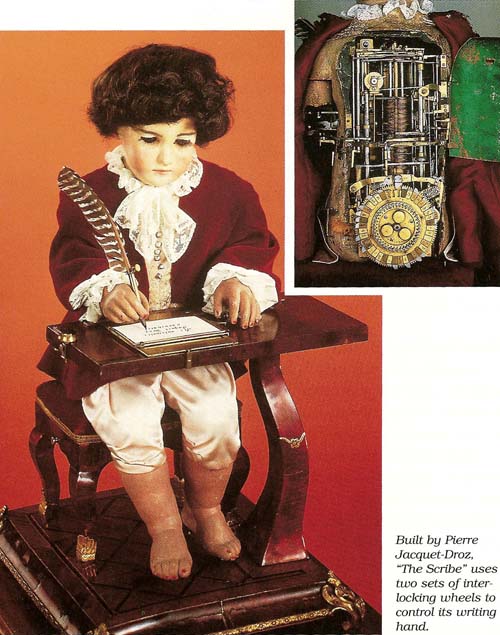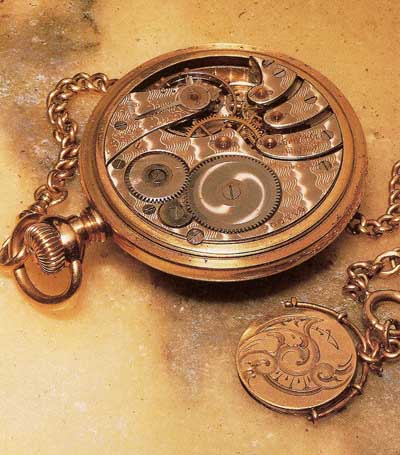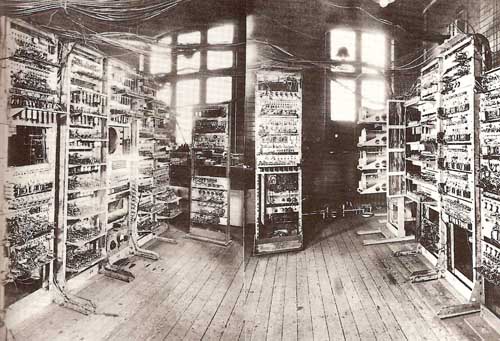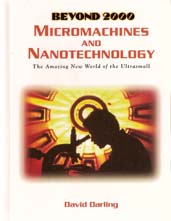MICROMACHINES AND NANOTECHNOLOGY: The Amazing New World of the Ultrasmall - 1. The Incredible Shrinking Machine

Figure 1. The Scribe automaton.

Figure 2. Small, finely-crafted parts allow this old pocket watch to keep accurate time.

Figure 3. This bulky computer of 1948 was many times less powerful than a modern personal computer.
Why should we try to make machines, or the parts inside them, smaller and smaller? First, miniaturization allows them to be carried around or moved more easily. A machine that is portable can be used in many more situations than a big, heavy device. Second, if a machine is built from very small parts, it can perform highly complicated functions. Instead of ten working parts, it might have a thousand, or ten thousand, or more. Because of its complexity, it can do sophisticated tasks that would be impossible for a simpler machine. Some of today's machines, such as television sets, compact disk players, and industrial robots, works in ways that would have seemed almost magical to people living a few centuries ago.
If you were to take apart a device like a car, a personal computer, or a washing machine, you would find inside a huge collection of bits and pieces, precisely manufactured and fitted together. We take such complicated products for granted and rarely think about exactly how they work. But centuries of effort have gone into developing the techniques of miniaturization on which our world now depends.
Among the earliest masters of the very small were the Chinese. Elaborate toys with tiny working parts were built in China as long ago as 200 BC. Over the next thousand years or so, all kinds of fantastic playthings, from mechanical flying birds to an otter that caught fish, wee made for the amusement of the Chinese emperors.
Time in Your Hands
Intricate toys have often been used to show off a craftworker's skill. But
in Europe, especially beginning about the sixteenth century, the desire
to produce small, finely made components stemmed from more practical needs.
One of these needs was for people to be able to tell the time wherever they happened to be. Before 1500 all clocks were big and unwieldy because they used heavy weights to drive their machinery. Then a German locksmith invented the mainspring – a coiled ribbon of steel that, as it unwound, drove a series of cogs connected to the clock's hands. Being light and compact, the mainspring allowed timepieces to be built that could easily be carried around. This advance made possible the development of the pocket watch and, eventually, the wristwatch.
In 1772, a Swiss clockmaker adapted the most advanced clockwork machinery of his day to make a lifelike doll that could write messages with a quill pen (see Figure 1). The doll moved its hand almost with the precision of a real person.
Inventions Galore
By the end of the Middle Ages, people were finding all sorts of reasons for building intricate new machinery with small working parts. Navigators needed very accurate clocks, called chronometers, to tell the time, so they could work out their position at sea. Scientists needed precision-made microscopes, telescopes, balances, and other measuring equipment in order to carry out more detailed experiments (see Figure 2).
As has often been the case in human history, was spurred the growth of new technologies. Gun makers were urged to improve the accuracy and efficiency of firearms, for instance.
With the development of the steam engine in the eighteenth century, complex machinery could be driven to weave cotton and to propel steam trains. The invention of the telegraph, radio, television, and many other devices followed, along with the means to deliver electric power into people's homes.
When a new device is developed, it may not work particularly well. It is likely to be clumsy, hard to move and operate, and expensive to manufacture. Along with other improvements, engineers try to find ways to make the parts of a new invention smaller and lighter (see Figure 3).
| Miniature Record Breakers
The most advanced scientific balances in the world are capable of measuring to an accuracy of 0.00000001 of a gram. The finest cuts have been made at the Lawrence Livermore Laboratory in California. Using a special device, scientists were able to slice a human hair 3,000 times lengthwise. |
It's a Small, Small World
To see how much progress has been made in miniaturization, compare the goods in a Sears catalog from around 1900 with the same kind o products available today. Think also about how much a personal computer can do than one of the world's most powerful, room-filling "electronic brains" fifty years ago.
We live in a world of advanced technology – made possible, in part, by our ability to manufacture very small, high-quality components. But just how small can human-made devices become?

